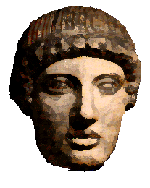Reading Latin poetry aloud
Metre & scansion
"Feet"
![[A Dancing Satyr]](animated.gif) The basic unit of poetry is called a "foot" - this was originally a
measure (Greek metron) of the time it takes to raise one foot
in dancing or marching and put it down again. It's similar to a bar
in music, or the off-beat + the on-beat in jazz and rock. By definition,
therefore , a foot has two equal parts (equal in time, that is). Lifting
the foot up (which the Greeks called arsis, and thumping
it down again (which they called thesis). A foot consists
of arsis (one long syllable, usually) followed by thesis
(another long syllable, or possibly two short ones making up the same
amount of time). The foot
The basic unit of poetry is called a "foot" - this was originally a
measure (Greek metron) of the time it takes to raise one foot
in dancing or marching and put it down again. It's similar to a bar
in music, or the off-beat + the on-beat in jazz and rock. By definition,
therefore , a foot has two equal parts (equal in time, that is). Lifting
the foot up (which the Greeks called arsis, and thumping
it down again (which they called thesis). A foot consists
of arsis (one long syllable, usually) followed by thesis
(another long syllable, or possibly two short ones making up the same
amount of time). The foot ![]() with
two longs is called a spondee, the foot with a long and two shorts
with
two longs is called a spondee, the foot with a long and two shorts
![]() is called
a dactyl (from the Greek for finger - your finger has a long
joint and two short ones). Sometimes found at the end of a line (see
below) is a trochee
is called
a dactyl (from the Greek for finger - your finger has a long
joint and two short ones). Sometimes found at the end of a line (see
below) is a trochee ![]()
"Lines"
The dancing would have been accompanied by music, and the music could of course have been the human voice. The dancers keep "in time" with the music, which is divided into a number of "feet" - during each of which the dancers raise and lower a foot. But although music supplied by instruments can be continuous, a singer has to breathe! Thus the song/poem tended to be split up into equal chunks allowing the singer to take breaths at regular intervals. This is the origin of the line (which of course only became an actual line much later when a poem could be reproduced in writing). Frequently there's a missing bit of the last foot of a line (see hexameter), corresponding to the point where the breath was taken. Most lines also contained a subsidiary pause about halfway through, where the singer could take a short breath - thus a line of verse can be "cut" into two sections - the place where the cut happened was called the caesura (Latin for cutting).
The Hexameter
![[A bard singing]](singer.gif) The line used by Homer and the Greek epic poets was adapted by the
Romans. It has 6 (Greek hex) metra, or feet, usually a
mixture of dactyls and spondees. Click on the ear icon to hear the sound!
The first line, about horses galloping, has an unusual preponderance
of dactyls, while the second is nearly all spondees, giving a very slow
and solemn effect. After listening to these, you'll appreciate why Virgil
normally prefers a fluid mixture of the two types of feet. Every line,
however will always end with the pattern
The line used by Homer and the Greek epic poets was adapted by the
Romans. It has 6 (Greek hex) metra, or feet, usually a
mixture of dactyls and spondees. Click on the ear icon to hear the sound!
The first line, about horses galloping, has an unusual preponderance
of dactyls, while the second is nearly all spondees, giving a very slow
and solemn effect. After listening to these, you'll appreciate why Virgil
normally prefers a fluid mixture of the two types of feet. Every line,
however will always end with the pattern ![]() |
| ![]() or
or ![]() |
| ![]() .
A red horizontal line | shows where the foot
ends, and // shows the caesura.
.
A red horizontal line | shows where the foot
ends, and // shows the caesura.
Click on the ear!





